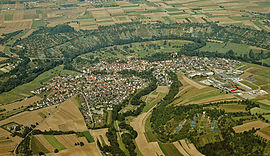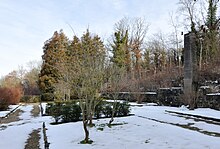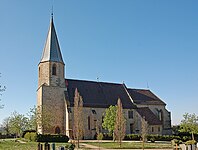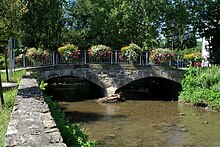Unterriexingen
|
Unterriexingen
City of Markgröningen
|
|
|---|---|
| Coordinates: 48 ° 56 ′ 19 ″ N , 9 ° 3 ′ 22 ″ E | |
| Height : | 194 m |
| Area : | 7.29 km² |
| Residents : | 2423 (Dec. 31, 2007) |
| Population density : | 332 inhabitants / km² |
| Incorporation : | 1st January 1973 |
| Postal code : | 71706 |
| Area code : | 07147 |

Unterriexingen is located on the Glems and has been a district of Markgröningen in the Baden-Württemberg district of Ludwigsburg since 1973 .
geography
geology
Unterriexingen lies on a river terrace of the Enz , which is divided by the Glems and rises to the south and was covered by a layer of loess from the Ice Age . Before that, Enz and Glems cut their way through the rock layers of the Lower Keuper and the Upper Muschelkalk over the course of millions of years . For example, river gravel from the Enz can still be found on the Muckenschupfs plateau southwest of the village .
Location and network of paths
The place is located on the northern edge of the Strohgau around four kilometers north of Markgröningen. The Glems and a Mühlgraben flow through Unterriexingen, which at times divided the community into two domains and come together at the Bachmühle and in front of the lower Glemsbrücke. The Glems flows into the Enz about 400 meters below the village . To the left of the Glems estuary there used to be a ford through the Enz. With dry feet, you could get to the steep vineyards of the village on the opposite Enzhang over a footbridge at today's Enzbrücke and directly to Großsachsenheim. To the right of the Enz a path ran over the Remminger Schlössle to Tamm . A path to Grüningen ran west of today's country road . Through the Glemstal one came to the deserted Guckenhäuser and Talhausen . To the west of the village, the roads forked to Pulverdingen and Oberriexingen or Enzweihingen.
Unterriexingen also includes buildings on the Hohberg, the Frauenkirche on the height southwest of the village and Aussiedlerhöfe in the west.
Neighboring places
The settlements Großsachsenheim , Untermberg , Markgröningen , Talhausen , Aichholzhof , Pulverdingen , Enzweihingen , Leinfelder Hof and Oberriexingen are around Unterriexingen (clockwise from the north).
Desolation
In the West, under Riexinger denunciation was probably in the 17th century by a dialed in place Burg Dauseck expanded. It is not known when the Guckenhäuser settlement in the Glemstal south of the Hohberg was abandoned. In the 16th century, the settlement of Remmingen east of Unterriexingen was given up in favor of Untermberg. It is possible that there was once a settlement near the Frauenkirche, but so far no information is available.
history
The plateaus around Unterriexingen were already settled in the Neolithic Age. Several burial mounds date from Celtic times. During construction work, a grave with gifts from the Merovingian era was found in Weberstrasse .
The name "Ruotgisina" appears for the first time in 793 in an inventory of the former Lorsch monastery . At this time there is no distinction between Unter- and Oberriexingen . This is first documented for the year 1342, in which the name "Nidern Ruexingen" is mentioned. In the original feud letter from 1396, the place was then called "Undern Rüxingen". Here the first known non-aristocratic residents of Unterriexingen are listed as subjects of Württemberg: "Barnhort Kratzenbuch, Schulthais zu these zitten, Haintz Schnider, Harman Engel, Haintz Metzensun, Hantz Melwer, Cuntz Kuof, Burklin Humelin, Auberlin Hamburg, Cunrat Seman, Bentz Klotz, he is called Schraden, and Hans Emhart von Grüningen ”.
The Frauenkirche outside the village was also a pilgrimage church
Unterriexingen around 1682 from the north (from the Kieser forest inventory book)
Once the castle of the Lords of Riexingen, then the castle of changing rulers
Power relations
Around 1100, the once noble lords of Riexingen appear in the register of the monasteries in Hirsau and Reichenbach . From 1396 at the latest, when the twelve Württemberg residents of “Undern Rixingen”, together with the renegade Grüninger citizens, had to swear eternal loyalty to the Württemberg counts by original feud letter, the local nobility shared the place with the House of Württemberg .
In 1447 Seifried Osterbronn von Riexingen sold his remaining property and the part in Unterriexingen that could be leaned from Württemberg to the related Schwarzfritz von Sachsenheim and settled at Bromberg Castle. Currently, the gentlemen from Riexingen are saying goodbye to their headquarters bit by bit. The last male representative of this sex was Georg II von Riexingen, who died in 1560. They were followed by the Lords of Sachsenheim, Jakob Christoph Schenk von Winterstetten , his sister Anna von Remchingen and finally their daughter Margaretha von Gemmingen , who bequeathed their district to the Lords of Sternenfels . Martin von Sachsenheim sold the Württemberg fiefdom in 1493 to Ludwig von Nippenburg . Subsequently, the lords of Lützelburg were enfeoffed with it until 1682 . From then on, more than half of the village was directly in Württemberg hands. The castle and 7/32 of the village sold the Sternenfelser in 1687 to the Lords of Sperberseck , whose share came in 1717 through marriage to the Barons Leutrum zu Ertingen . In 1763 Ludwig Christoph Leutrum zu Ertingen sold his share of the place to Johann Friedrich Erasmus von Hopfer, who had owned the Pöllnitzschen Schlösschen since 1762 (demolished in 1969). In 1815, Hopfer's property came back to the Leutrum von Ertingen family through marriage. After twenty years of vacancy, the family of Countess Irmela Leutrum zu Ertingen and Prince Alexander von Ratibor and Corvey live in the castle, which was renovated in the 1970s.
The inhabitants were either subject to local rule or subject to Württemberg, at times depending on the location of their house on the left or right of the Glems as a natural border. The Württemberg residents were mostly assigned to the Grüningen Office (from 1758 Oberamt) and, after its dissolution, from 1806 to 1938 to the Oberamt Vaihingen . With the rise of Württemberg to a kingdom from 1806 until the end of the First World War, the family of the local aristocracy was also subject to the king by Napoleon's grace.
Until the Reformation , the Frauenkirche and the village church belonged to the Vaihingen rural chapter in the Archdiaconate of Trinity of the Diocese of Speyer .

Contemporary history
During the Nazi era, several bunkers and tunnels were built on the right edge of the slope towards the Enz in the course of the Neckar-Enz position . On the Unterriexingen markings, some remains of these structures, which were built in 1936/37 and were mostly blown up after the war, are still visible. Under the code name "Gallinit", a tunnel system was driven into the slope on the left side of the Enz during the war. They should serve for the underground, bomb-proof production of armaments.
From October 1944 to May 1945 there was a subcommand of the Wiesengrund concentration camp in Vaihingen an der Enz in Unterriexingen , which in turn was a satellite camp of the Natzweiler-Struthof concentration camp . The prisoners were mainly used to build airfields, tunnels, in the quarry and to clean up after air raids in the area. Inadequate nutrition, hard labor and, in some cases, the arbitrariness of the guards, 250 out of 500 prisoners died. The concentration camp cemetery above the road towards Oberriexingen is a reminder of them.
During the Second World War , the community lost 70 residents who died in combat or in captivity. There were no civilian casualties.
As a result of the expulsion from their homeland , numerous Catholics came to the village, which led to the construction of the Catholic church in the Nonnenpfad and the erection of the Ostlandkreuz above the Frauenkirche. In 1960 a New Apostolic Church was also consecrated.
On January 1, 1973 Unterriexingen was incorporated into Markgröningen.
On July 25, 1980, the RAF terrorists Juliane Plambeck and Wolfgang Beer were killed in a collision with a gravel transporter on the road to Untermberg (K 1684).
politics
The merger with the neighboring dwarf town of Oberriexingen , which was proposed in the course of the community reform and which is obvious because of the name , was rejected by its citizens. The Unterriexinger felt more closely connected to Markgröningen anyway and, with 87.3 percent of the votes cast, they were in favor of incorporation into Markgröningen, which took place on January 1, 1973. Unterriexingen brought in 1889 inhabitants and 729 hectares of land on the reporting date.
The false choice of part of the town was supposed to guarantee that the inhabitants of Unterriexingen would in future be adequately represented in the Markgröningen municipal council. The mayor Heinz Keck, who was in office until 1972, became first alderman in Markgröningen until he retired. After that, this post was no longer filled. Lately the abolition of the false choice of part of town has been discussed.
coat of arms
The blazon of the Unterriexinger coat of arms changed in 1936 reads: A black eagle catch in gold.
Until then, the coat of arms showed the foot of a swimming bird in different variants, which can still be found on old boundary stones along the former boundary (see illustration). The seal of the community also bore a waterfowl's foot, a leg of a goose. During the Nazi regime, the eagle-horned "cuckoo's mallet" was created, which the municipality had in its coat of arms until 1972.
Culture and sights
music
In Unterriexingen there is the music association with wind orchestra and youth band as well as the singing association Eintracht, which appear on various occasions such as the “Fleckafescht” or the “Musikantenlaube” and are an integral part of the Schäferlauf festival.
Flatly
A circular route (approx. 5.4 km) signposted by the working group for historical research and the preservation of monuments in Markgröningen leads past the architectural and cultural landscape sights in and around Unterriexingen. The starting point is the Kelterplatz, it takes just under two hours.
Buildings
There are a number of buildings worth seeing in Unterriexingen. For example
- the castle Unterriexingen , a former castle with remains of a residential tower from the 12th century and a keep from the 14th century,
- the Meierhof and the wine press at the castle,
- the old town hall and the bakery on the main street,
- the evangelical parish church and the parsonage as well as renewed by Bruno Taut in 1906
- the Frauenkirche , built in the 14th century , the ruins of which were extensively renovated in 1874 by Gerhard Graf Leutrum von Ertingen and equipped with a monumental Romanesque crucifix.
Baking is still done regularly in the community's bakery. It has two ovens and a fruit kiln. The “Röhrleskuchen” became a household name beyond Unterriexingen.
August Ludwig Reyscher was born in the rectory
Sports
TSV Unterriexingen
Sports activities in Unterriexingen are mainly offered by the gymnastics and sports club Unterriexingen (TSV) with its football and gymnastics departments, which mainly use the two grass pitches in the Enzwiesen as well as the gymnasium and festival hall. The club, which was founded in 1923 and currently has around 720 members, has a new clubhouse opened in 2008 with an attached sports restaurant. In addition to the sports fields located here, there is also a small playing field at the Glemstal primary school in Talstrasse.
In terms of sport, the gymnastics and sports club and its football players are represented in the district league in the Enz / Murr district of the Württemberg football association in the 2016/17 season .
SV Unterriexingen
In the field shooting which offers shooting club Unterriexingen (SV) systems for pneumatic weapon , for small caliber pistol and rifle , large-caliber pistol and rifle and free pistol . The rifle house is located outside the village on the Hohberg.
Bike paths
The approx. 40 km long Glemsmühlenweg , which starts at Glemseck near Leonberg , ends at the Unterriexinger Bachmühle . The approx. 100 km long Enztal cycle path touches the village in the north of Oberriexingen and continues to Untermberg . In 2013, two bridges over the Enz were built for 1.36 million euros and the previous route along a heavily trafficked road that is poorly suited for cycling was disarmed, creating “the most expensive cycle path in the district”.
Personalities
Sons and daughters of the church
- August Ludwig Reyscher (* 1802 in the rectory; † 1880 in Cannstatt), lawyer , legal scholar and politician (member of the state parliament and Reichstag), the only honorary citizen of Unterriexingen (appointed on December 24, 1842). He left a description of his youth in Unterriexingen.
- Albert Brodbeck (1864–1938), Oberamtmann of Württemberg
- Ulrich Noack (* 1956), lawyer and professor at Heinrich Heine University in Düsseldorf .
Personalities who have worked on site
- Marie-Luise Countess Leutrum zu Ertingen (* as Marie-Luise Steiner 1905 in Laupheim; † 1980 in Heidelberg), graduate farmer ( Hohenheim ), 1948 founder and first chairwoman of the German Rural Women's Association , whose office was then in Unterriexingen Castle.
literature
- 1200 years of Markgröningen. Festival book for the 1200th anniversary of the first written mention of the name . Ed .: City of Markgröningen, Markgröningen 1979.
- Hilde Fendrich: Unterriexingen in the 19th century . In: Through the city glasses - history and stories about Markgröningen , Volume 2, 1986, pp. 65–114. Volksbank Markgröningen-Schwieberdingen und Umgebung eG, Markgröningen 1986.
- Hans-Burkhard Hess: Unterriexingen - a historical kaleidoscope. Markgröningen 1993, ISBN 3-929948-00-1 .
- Ludwig Friedrich Heyd : History of the former Oberamts-Stadt Markgröningen with special consideration for the general history of Württemberg, mostly based on unpublished sources . Stuttgart 1829, facsimile edition, Markgröningen 1992.
- Gerhard Graf Leutrum von Ertingen (ed.): The Graeflich-Leutrumsche Frauenkirche in Unter-Riexingen . Kohlhammer, Stuttgart 1891.
- Karl Eduard Paulus : Description of the Oberamt Vaihingen . Issued by the Royal Bureau of Statistics and Topography. Hallberger, Stuttgart 1856. pp. 239ff. Wikisource .
- August Ludwig Reyscher : Memories from old and new times (1802-1880) . Edited by Karl Riecke. Mohr, Freiburg u. Tübingen 1884.
- Elsbeth Sieb: Unterriexingen: In old pictures. Geiger-Verlag, Horb am Neckar 1989, ISBN 3-89264-293-1 .
Individual evidence
- ↑ See forest map 158 (Enzweihingen) by Andreas Kieser (1682) Leo-BW online
- ^ Archival documents in "causa equestri" , Cap. I., Sect. I. No. 5, p. 5
- ↑ Ludwig Friedrich Heyd : History of the former Oberamts-Stadt Markgröningen with special consideration for the general history of Württemberg, mostly based on unpublished sources . Stuttgart 1829, facsimile edition, Markgröningen 1992, p. 33ff. Baden-Württemberg State Archive online , HStA Stgt., A 602 No. 652 a = WR 652a
- ↑ LABW, HStA Stgt., A 602 No. 652 a = WR 652a LABW online .
- ↑ Hans-Burkhard Hess: Unterriexingen - a historical kaleidoscope. Markgröningen 1993, p. 256ff.
- ↑ 1200 years of Markgröningen. Festival book for the 1200th anniversary of the first written mention of the name . Ed .: Stadt Markgröningen, Markgröningen 1979, p. 104f
- ^ Federal Statistical Office (ed.): Historical municipality directory for the Federal Republic of Germany. Name, border and key number changes in municipalities, counties and administrative districts from May 27, 1970 to December 31, 1982 . W. Kohlhammer, Stuttgart / Mainz 1983, ISBN 3-17-003263-1 , p. 453 .
- ↑ Article in the Frankfurter Rundschau from July 26, 1980 Juliane Plambeck killed in an accident ( Memento from June 2, 2008 in the Internet Archive ). Retrieved October 22, 2009.
- ↑ See Jochen Ansel, Karl Halbauer, Sophie Richter: The Romanesque crucifix of the Frauenkirche in Markgröningen-Unterriexingen. In: Denkmalpflege in Baden-Württemberg , 36th year 2007, issue 1, pp. 32–41 ( PDF ( Memento of November 3, 2013 in the Internet Archive ))
- ↑ [1]
- ↑ Enztal cycle path: District Administrator Dr. Haas and Mayor Kürner inaugurate a new section near Unterriexingen. landkreis-ludwigsburg.de, September 17, 2013, accessed on January 22, 2014 .
- ^ Günter Bächle: The most expensive bike path in the district. lkz.de, June 24, 2012, archived from the original on March 4, 2016 ; accessed on January 22, 2014 .
- ↑ See August Ludwig Reyscher : From old and new times. JCB Mohr, Freiburg and Tübingen 1884.
Web links
- Official website of the city of Markgröningen
- Circular route and cultural monuments in Unterriexingen at the working group for historical research and monument preservation in Markgröningen



















